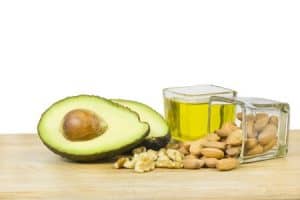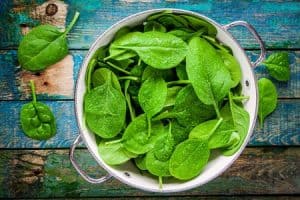
When you’re busy, on the go, traveling, in a restaurant or in some (inconvenient) convenience store it’s important to know the basics so you can make the BEST CHOICE for the situation you’re in and fuel your body.
Remember ALL OR SOMETHING, not “all or nothing.” You don’t have to give up or feel derailed from your goals just because you have a less than ideal meal.
I don’t always have time to prep food every week (though I do every chance I get) and I travel frequently – and I’m often very busy and on the go – so I have a simple checklist that I keep in mind that helps me stay on track in a variety of situations.
This is…
Betty Rocker’s 5-Step Healthy Eating Checklist:
1: IDENTIFY THE NUTRIENTS
Whatever you’re eating, look for what NUTRIENTS (protein, carbs, fats, greens) are in the meal.
If you can start to identify where these are coming from in your meals, you can start to choose better and better whole food versions of them – and start to see how they work together to really boost your metabolism, shed excess body fat and provide you with lasting energy and vitality.
Look for:
PROTEIN: Include Protein with all of your meals – I can’t say enough about the importance of this! Protein is more satiating (satisfying) in the long run than fat or carbs. Over time, protein can simultaneously reduce your hunger hormone (ghrelin) levels and boost your levels of a satiety hormone (peptide YY).
It will help you change your body composition from carrying extra fat to carrying lean muscle, which burns more calories at rest and will start to carve out those lean lines so many people want to see in their bodies.
Eating protein is not going to “bulk you up.” It’s an important nutrient that’s responsible for multiple body functions.
If you’re constantly craving sugar or sweets, it is important to take a look at the nutrients in your daily dietary intake to see if you’re getting enough protein, fat and complex, wholesome carbohydrates.

Order as “clean” of a protein source for your eating style as you can at a restaurant, and leave off excess sauces when possible – they’re often loaded with sugar and sodium that aren’t doing your body any favors.
For more on how much protein you need, when, read this article, and for healthy food options when you’re traveling, try this article!
CARBS: Properly prepare and include the RIGHT wholesome slow-digesting carbohydrates – and when you can’t prepare your own, look for the best source you can find in the situation you’re in.

Yes, it’s ideal to have fibrous vegetables and whole grains that have been soaked, sprouted or fermented (think Ezekial sprouted grain breads and cereals, overnight oatmeal) but in some situations, you just need to make sure you’re getting something that will be slow-digesting and provide you with energy.
Stick to sweet potatoes, regular baked potatoes, rice, beans – and try to avoid the added sugars that often come laden in the toppings or sauces. Look for the best carb choice you can – a packet of instant, plain oatmeal is a better choice than the muffin in the break room.
Enjoy some fruit if that’s closer to a whole food option without the additives, and try not to rely just on fruit throughout the day. Fruit is fructose, a sugar that is processed by the liver, which can only process/store a certain amount daily. Once it’s full, it starts to store excess in your fat cells.

Look for quality fats in simple foods like nuts, nut butters, avocados, seeds, and heart healthy oils.
When I’m out to eat, if I’m having a salad I’ll skip their pre-made dressing but order a side of olive oil and fresh lemon and make my own so I don’t miss the good fat, but skip the sugar and other less than ideal ingredients in the pre-made dressing.
If I’m looking for nut butter, I look for the one that doesn’t have sugar added.
I’ll have real, whole butter when that’s the best option. Look for the nutrients available around you in every situation and you’ll be so far ahead of the game.

Some of my greens shortcuts are to include greens in a protein shake, have raw veggies as snacks (usually with peanut butter or Greek yogurt), make a big mixed greens salad for the week in advance that I have with a protein and carb (I keep the salad un-dressed to keep it from getting soggy).
I also have organic Berry Green Protein as a backup when I’m out of greens, am traveling or just want the convenience of boosting any smoothie with 18 grams of protein, and a variety of greens and fruits.
2: AVOID FOODS WITH ADDITIVES, ADDED SUGAR, and UNNECESSARY PROCESSING
…unless you’re having them ON PURPOSE as a treat (balance is important – but don’t nickel and dime your sugar intake away on sugar-laden processed foods).
When I say “unnecessary processing,”here are a couple examples.
I would avoid “fat-free” yogurt and opt for a full-fat yogurt. It’s been processed less, and most likely doesn’t need added sugar and sodium to make it taste good because the natural fat (which works perfectly with the healthy protein in the yogurt to make it more bioavailable to your system) makes the yogurt taste better.
I would avoid products like “PB2” which is just peanut butter with the natural fat sucked out and sugar added in. Less fat doesn’t mean “better for you,” it’s just tricking you into thinking that’s better for you. When you eat PB2, you’re not as satisfied as when you eat real peanut butter, and the extra sugar can end up getting stored as fat since it’s easier to overeat it when all your foods contain added sugar.

See if it’s something natural or if it’s something that’s been manufactured. This is what I consider my due diligence.
Marketing is really sneaky and hard to navigate. Endless shortcut foods exist that promise you a quick fix to a healthy body – but so many of them are actually worse for you than a more simple whole food alternative.
For example, I would choose a handful of whole almonds over a bag of “100 calorie crisps” because even though the crisps are trying to trick you into thinking you’re going to “get skinny” by eating “less calories” you’re going to be eating something loaded with sodium that won’t actually satisfy your hunger as much because it doesn’t have much substance.
Nutrients trump calories every time: learn which ones your body needs and seek them out as your primary focus.
3: BE CONSISTENT WITH YOUR EATING HABITS

I follow a concept called “NSA” or “no strings attached” eating – not cheating – because I believe that we should be able to enjoy special occasions, a slice of cake, cocktails or whatever it is – ON PURPOSE, without the guilt.
Mindful eating makes us more aware of what’s at the end of our fork, and we’re more conscious of our daily choices, be they the ones that nourish us or the ones that simply enhance a moment with friends or a special occasion.
It’s all about balance.
4: HYDRATE
Drink plenty of water, and avoid sugary beverages.
My favorite way to stay hydrated all day long is to use the Water Minder App. You may have heard me mention this before – that’s because I’m a HUGE FAN of getting a reminder on my phone periodically throughout the day about something that helps me!
I often use it to do a quick stretch or break from looking at the computer – just having that little healthy reminder is a great way to help you stay hydrated. Take your water bottle with you everywhere you go, and sip on it regularly.
5: PLAN WHEN YOU CAN

Maybe a healthy soup or chili? Or simple baked chicken you can cook that will work in a salad, a dinner entree, and that soup? Sometimes simple is best when you’re busy and short on time.
Doing just a little time-saving food prep can be a great way to make sure you have at least a few staples on hand and lunches to pack, food to grab on the go, or something easy to make when you get home from a long day. You can always use my meal plans for variety, pre-done shopping lists, healthy whole food options and daily menus.
The same rules apply when you’re grocery shopping as they do eating out – choose the best things you can for the place you live and what your budget allows.
If you’re focusing on the nutrients, you can’t get this wrong – it’s ok if you don’t get organic and if you need to rely on some pre-made foods. Just do the best you can for the situation you’re in and look for the least processed option available of the nutrients you need.
Things like a mixed greens salad for the week, a couple protein and carb options like baked chicken and turkey burgers for example plus some overnight oatmeal and sweet potatoes would set you up with some basics that you could build around.
Keeping these 5 strategies in mind helps me stay on track when I’m short on time, in situations where I can’t cook or shop for everything I want to cook, and when I’m on the go.
Remember, it’s not about “all or nothing” – take the “all or something approach, and just look for the best option for the situation you’re in.

In an ideal situation, you’d shop at the Farmer’s Market, you’d have fresh, organic produce and wild-caught fish, you’d look for grass-fed meat, free range eggs and you’d easily find quality pre-sprouted, soaked or fermented quinoa, bread, or other grain products.
But we don’t always get that option, so what’s the next best?
My rule of thumb is that when you can’t find the highest quality, look for the nutrients in the food that your body needs, and get the cleanest source of food that contains them.
There’s no question that you need protein, slow digesting carbohydrates, healthy fat and greens. If you can’t get the most high-end source of these nutrients, don’t sweat it.
Focus on the nutrients themselves and get the best you can for your money where you are. This is exactly what I focus on when I’m traveling, whether I’m in a rural town, a restaurant or an event with limited options.
As always, if this was helpful, share it with a friend who could benefit from it as well!
For time-saving healthy eating, check out the Body Fuel System!
The Body Fuel System uses my simple, proven Eating Types to make it easy to stay on track. It also gives you healthy, fat-burning recipes and foods you can eat to look and feel your BEST every day!
Recipes like….
This is my signature eating system and it contains 6 weeks of done-for-you meal planning and recipe guides! You will not only learn the strategies that have given me long-term success, but also enjoy the time-saving benefits of having it all planned out for you!



